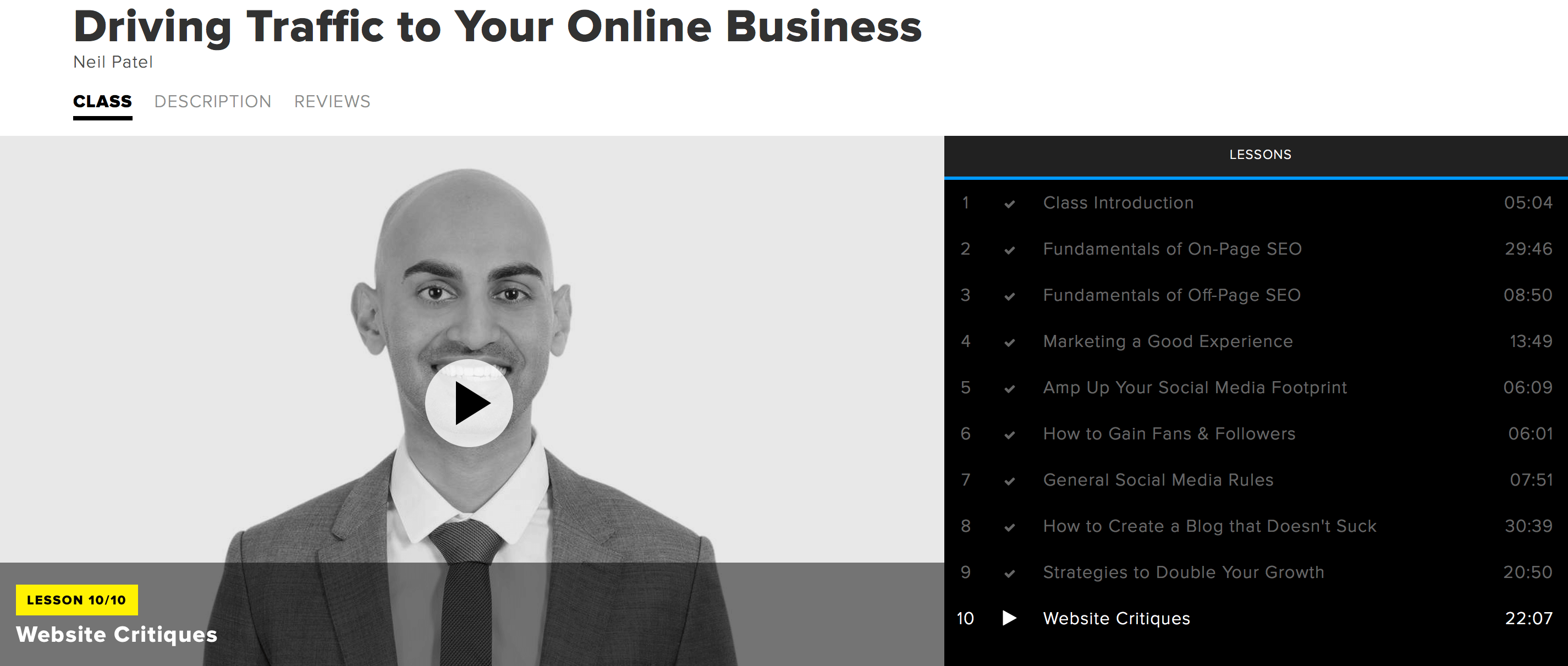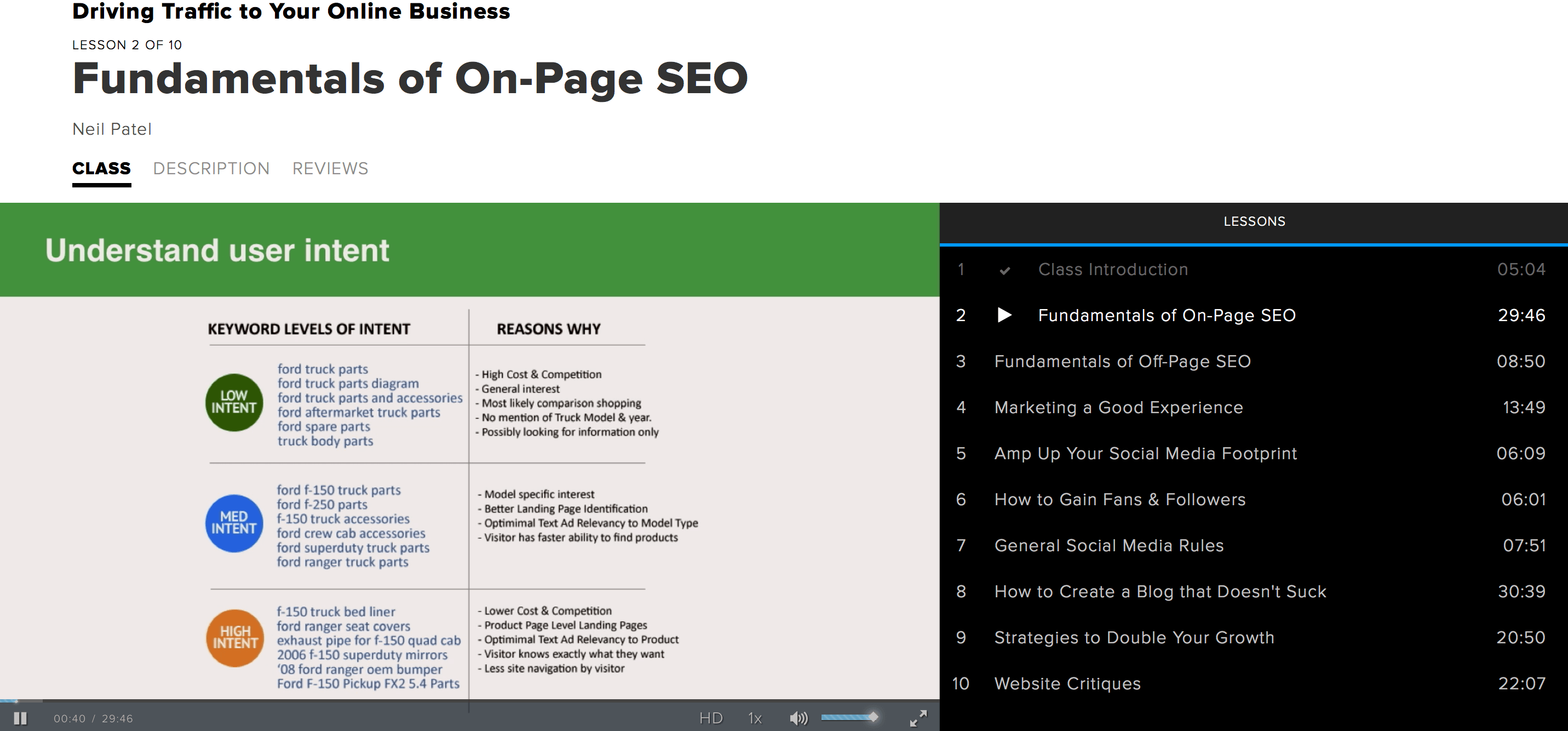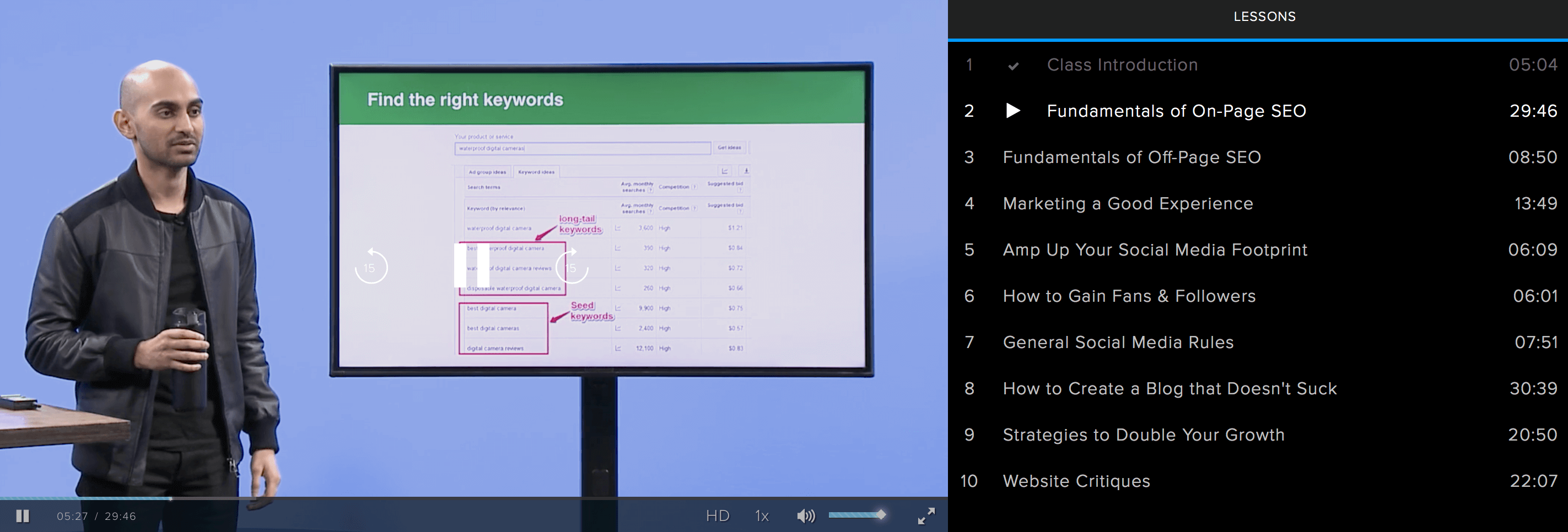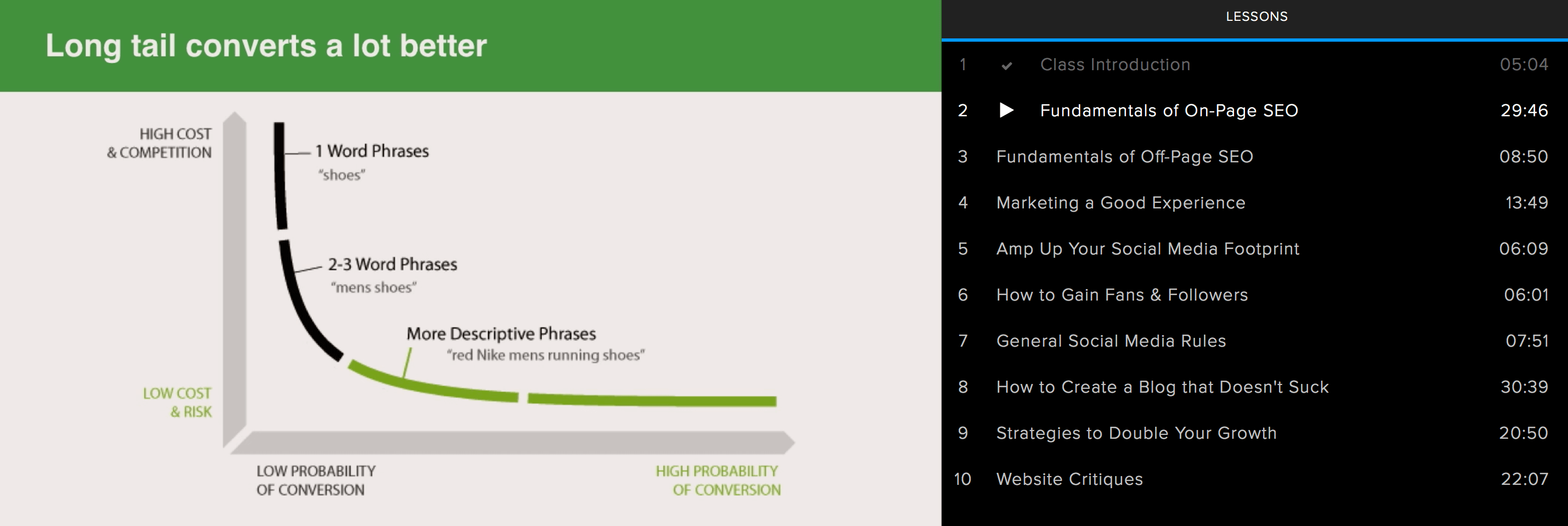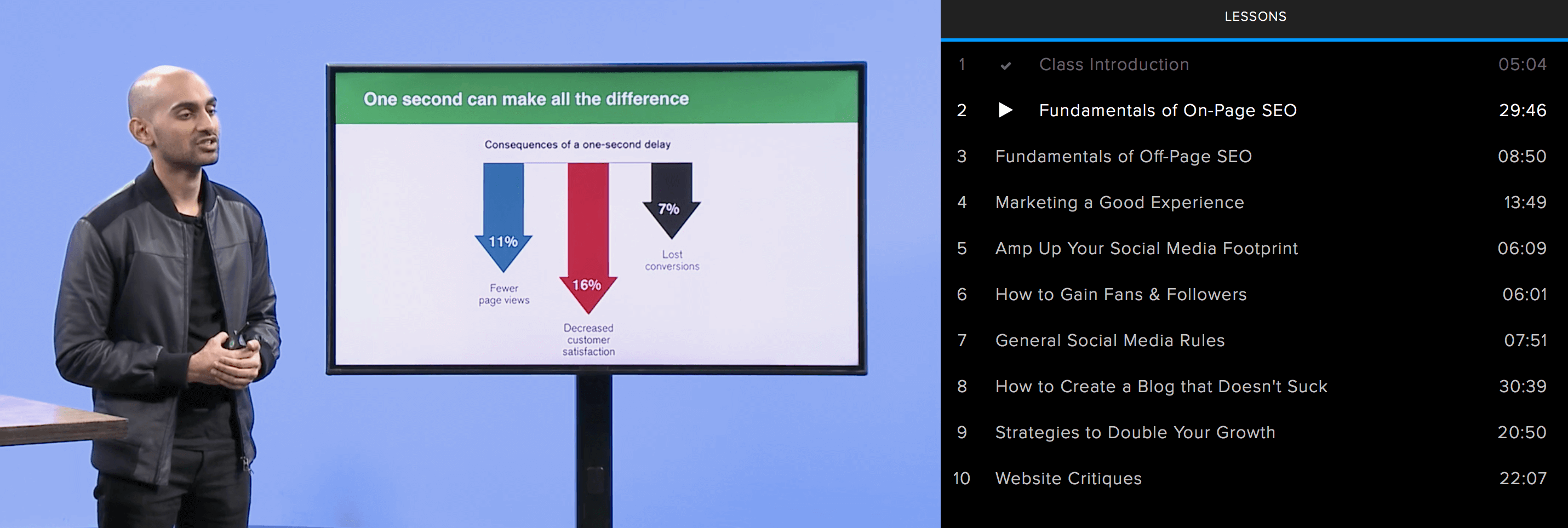I’ve recently been revamping my website.
I’ve been posting in different forums hoping to get some more targeted traffic.
I’ve revamped my email newsletter and made a free lead generator (you can see the 233-page book I’m giving away in return for people signing up here).
And I’ve even started recording my own podcast and just finished a video course.
I did all this without consulting many outside sources.
And despite the fact that I’ve never taken a formal SEO course, my search engine optimisation skills are on point.
This comes from an understanding of human psychology with a tiny smattering of keyword skills and google algorithm knowledge.
So my curiosity was peaked when I saw Neil Patel’s course being big on SEO.
What could I learn to make my good skills great?
How To Drive Traffic To Your Online Business – Neil Patel Creative Live Course Review
Neil Patel gets right into it in this Creative Live course.
The stuff at the beginning includes a lot I knew already, but to be fair it is good to have a refresher.
I’m talking about the difference between high intent and low intent keywords.
Basically the more super specific you get with your keywords, the smaller traffic you’ll get but the higher conversion percentage when it comes to people purchasing.
Specific searches = people sitting there ready with their credit cards.
For example, no one is searching for ‘Apple rose gold MacBook’ if they weren’t interested in buying. Otherwise they’d just type in ‘MacBook’.
The more specific = less competitive = less traffic = higher conversions for buying.
Takeaway?
Go for long-tail keywords.
This is basic stuff, but if you don’t really know what that is, and you want to drive traffic to your online business, Neil Patel’s Creative Live course is for you because it starts you off with the solid fundamentals you need to know.
Don’t optimise for keywords that don’t generate any income.
You can go to Google Planner which is a free keyword tool and you’ll see the keywords that cost the most to bid on.
They cost a lot because they generate the most cash.
More expensive per click = keywords that convert better.
This is not a traffic game.
Sure, it can be if it generates income.
But you don’t want to focus on keywords that generate millions of page views if they don’t make you a cent.
You know, despite this being basic, this did get me thinking again.
Sometimes we really do need to return to what’s important.
I’ve personally found tons of specific long-tail keywords that generate high volumes of traffic but they don’t earn me shit.
Think of all the time wasted in making content for those subjects. I should have been looking at the keywords that are more expensive per click.
“Traffic isn’t everything. It’s about relevant traffic.” – Neil Patel
Embedded within the basic fundamental advice (which, trust me, was still massively helpful as a refresher) there was a lot of stuff I didn’t know. Again, still basic. But was to do with how to figure out what content to generate.
Neil’s tips were immediately practical for me and really helped me out on a niche site I’ve been working on.
Look at your competitors, see what keywords they rank for, see if it’s high cost per click.
If it is, it’s probably a good keyword to go for and generating some money.
I never personally liked the idea of looking at competitors, but I guess that’s a non-business mindset I need to get out of (especially because I don’t like seeing anyone as competition). I’ve got to get out of my comfort zone and do some of this stuff.
About half way into the first module, I started getting more and more stuff that was tickling my brain in different ways.
This is when my note-taking really sped-up.
Looks like there certainly is plenty for me to learn.
Like, I didn’t even know about latent semantic indexing. If you’re already into SEO, this means something to you – if this doesn’t mean anything to you and you’d like to get a better grip on your company’s SEO, Neil’s Creative Live course is worth checking out.
This basically means Google bolds other relevant keywords when you do a search (e.g. “photos” and “pictures” are pretty much the same word).
This course really really hit home the importance of dedicating time to certain practices.
For example, the meta-description, you know the small description you see in Google after you’ve searched for something?
THAT’S what people are clicking on.
Did you know that 43.2% of people (almost half!) click on a given result based on the meta-description alone?
You shouldn’t be leaving your meta-description to chance, like I’ve lazily done on more than a few occasions.
You write something you’re proud of and you want to make you money?
Well spend some time crafting a great meta-description or it will go to waste (Neil shows you how to do this too).
Adding modifiers like “2015”, “best”, “guide”, and “review” can help you rank for long tail versions of your target keyword.
Actually before the first module of Neil’s course was finished, I had to pause the video to immediately implement his advice.
Do you know how common that is?
How often does that happen to you when you’re taking a course?
The info is SO GOOD and so practical and relevant that you feel compelled to put it into action immediately.
That’s the sign of a great course.
I also got a ton of value about speed checking your site and off-page SEO.
Off-page SEO is all about links.
The more links you get, the higher you’ll rank.
But all links aren’t created equal.
Those with more authority and relevance will be a better link.
Question: how do you get these authoritative sites to link to you?
I actually wasn’t expecting Neil to answer this question (maybe I’m jaded from lots of lacklustre courses), but he did and immediately dove into a bunch of link building techniques.
This was really cool.
I won’t list all of them because you need to get the course, but some of my favourites, the ones that made me go, “Huh! You can do that?!” were…
- Broken link builder technique: email those who have broken links to your competitors – “Hey, noticed it’s broken, but you could link to mine which is a bit better.”
- Skyscraper technique: make the best content (instead of 30 ways to do x, 100 ways), then write to the people who linked to the original content and ask them to link to his too.
- Internal linking: the reason Neil ranks number one for ‘online marketing’ is because he links to that page in every single other page on his website. His sidebars tell you to check out his online marketing guides.
- Do guest posts at places like Forbes: find writers already writing at these places, strike up a convo, and ask them for an introduction to an editor and they’ll do it. Find guest contributors and ask for intros. Don’t go to editors or Forbes directly. Writer to writer intro is more powerful than a cold email.
- Ego bait: write posts that flatter leaders in your industry, which help you develop relationships with these potential mentors, while simultaneously earning you backlinks from the leader’s existing followers.
I loved hearing Neil talk about how to Market a good experience.
It takes 12 positive experiences to make up for one negative experience.
Easy to lose, harder to gain.
For me, because there was so much information it could become overwhelming, I decided to take just three points that I could implement THIS WEEK and put them into practice FIRST.
So the three ones most valuable to me that I can start working on right now are:
- Site speed (get the site working faster)
- Work on getting links through ego bait, guest posts, broken link, and skyscraper techniques
- Find out what profitable keywords my competitors rank (also figure out who my “competition” actually is)
Neil’s social media advice was decent, but would have liked even more depth on this, especially as I feel completely clueless when it comes to social media.
Neil’s philosophy of social media is if it feels like a chore to you, stop doing it.
You should be posting content you love, whenever you have time.
Spend $100 on some ads to get started, and cross-promote, shout out for shout out.
Comment, get involved, start conversations.
Share other’s articles (even competitors) and start getting involved.
Share, do stuff that people online do.
How to create a blog that doesn’t suck:
This was another great module and the reason I liked it so much is because, firstly, if you’re a beginner this will be extremely insightful.
You’ll learn a TON.
But I loved the fact that Neil’s approach was refreshing to me, set up so that he didn’t assume I wasn’t already intelligent, and I consistently learnt new stuff that should have already been basic knowledge.
So if you’re just starting your blog, Neil Patel’s Creative Live course is a great one to get.
It’s quick and full of instantly applicable practical advice so you can get to work on your blog the same day you watch the course.
It’s also great for veterans or people who have been in the blog game a little while now and need to sharpen their tool kit.
Neil gives a bunch of unorthodox strategies guaranteed to double your growth.
My favourite strategies included:
- Flipping around your funnel. E.g. What if you offered consulting every day for a month for $7? Or “I’ll give you a service without you entering your email.” Or “I’ll give you a product and you just pay shipping.” It’s all about low commitment on the consumer end.
- Give homework assignments (follow up with your customers). Like the trader who gives seven homework assignments before you’ve even bought anything. You’ll be much more committed to buy if you have them doing stuff immediately. Train your visitors to buy. You have to train them that they need to take an action in order to receive a benefit. From clicking on a link, to watching a video, to even putting an email address in. Ask for micro-commitments, give before you ask, and be patient.
- Quiz your visitors. There’s a 281% increase in signups when making people fill out a quiz first (just a small 5-questions quiz is good enough).
There’s a whole lot more great stuff in Neil Patel’s Creative Live course.
If you have an online business, I consider it a much-watch.
You can check out Neil Patel’s Drive Traffic To Your Online Business at Creative Live here.
